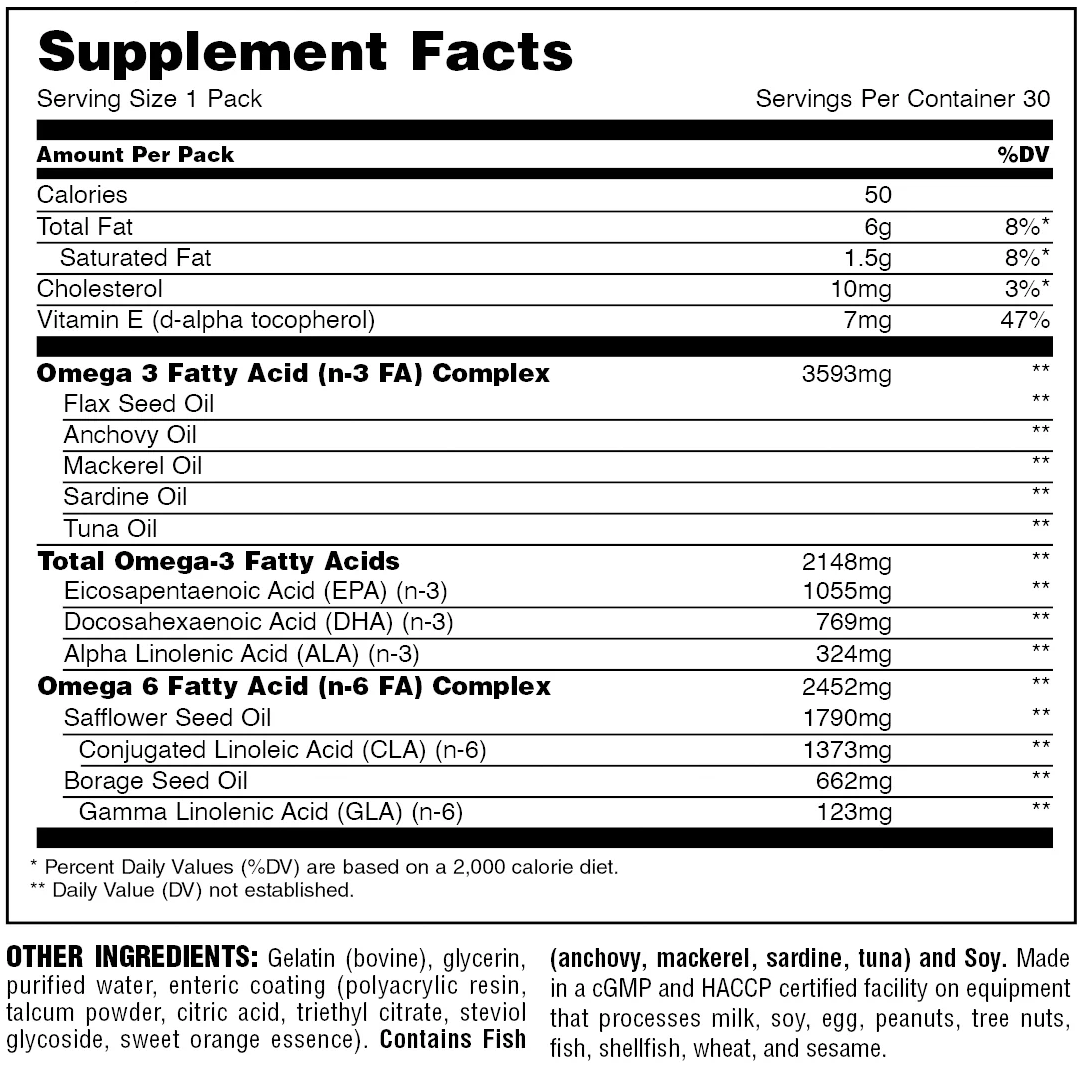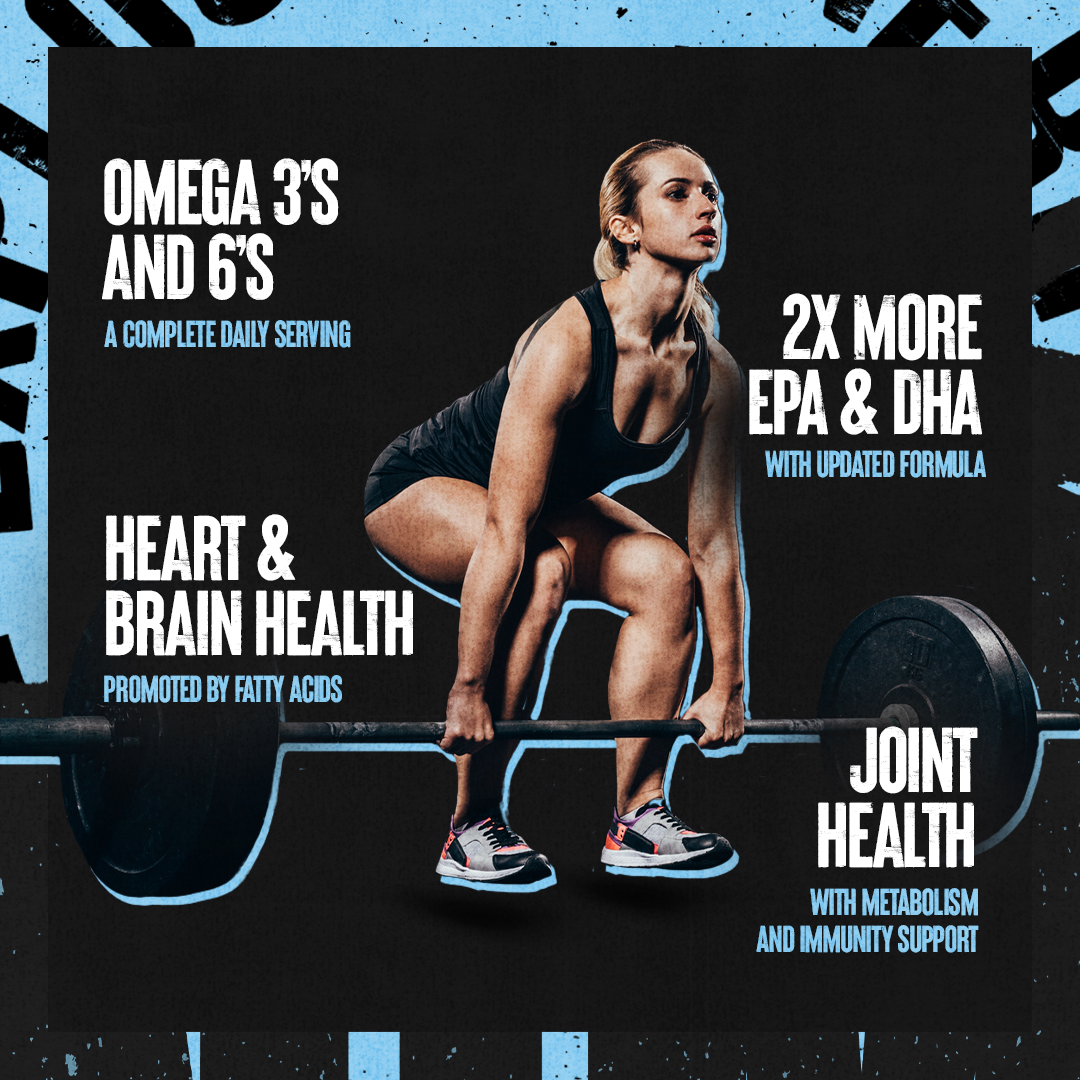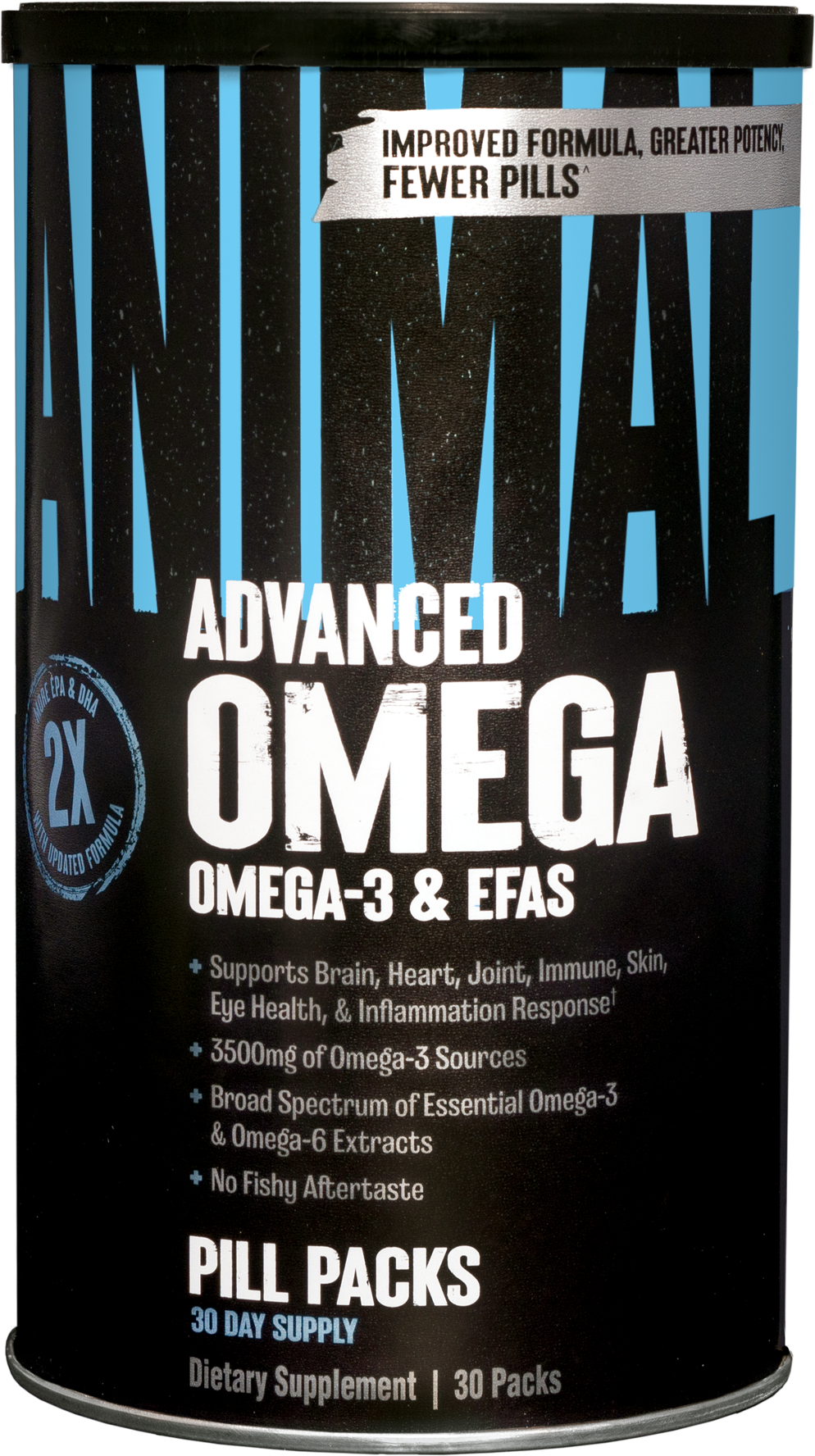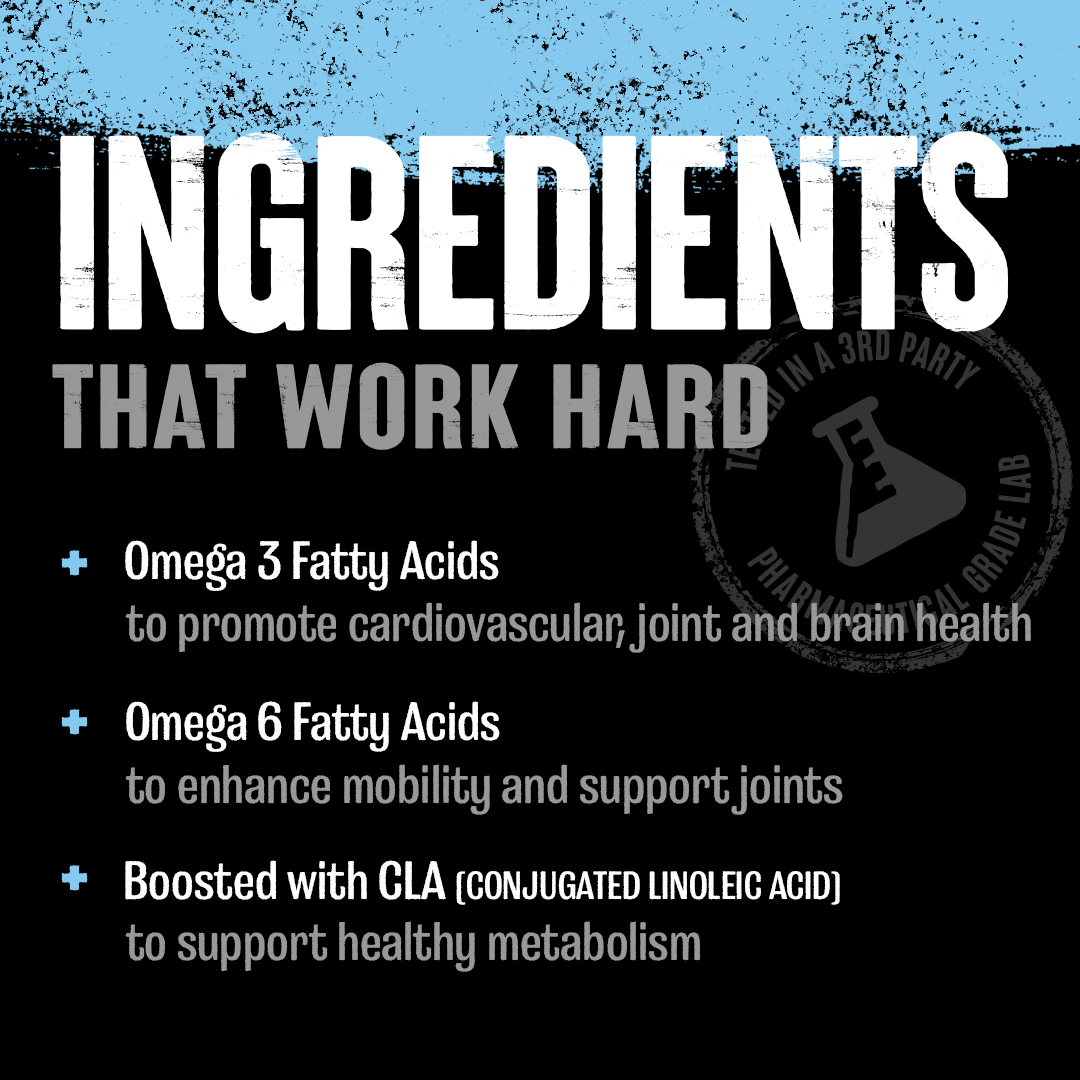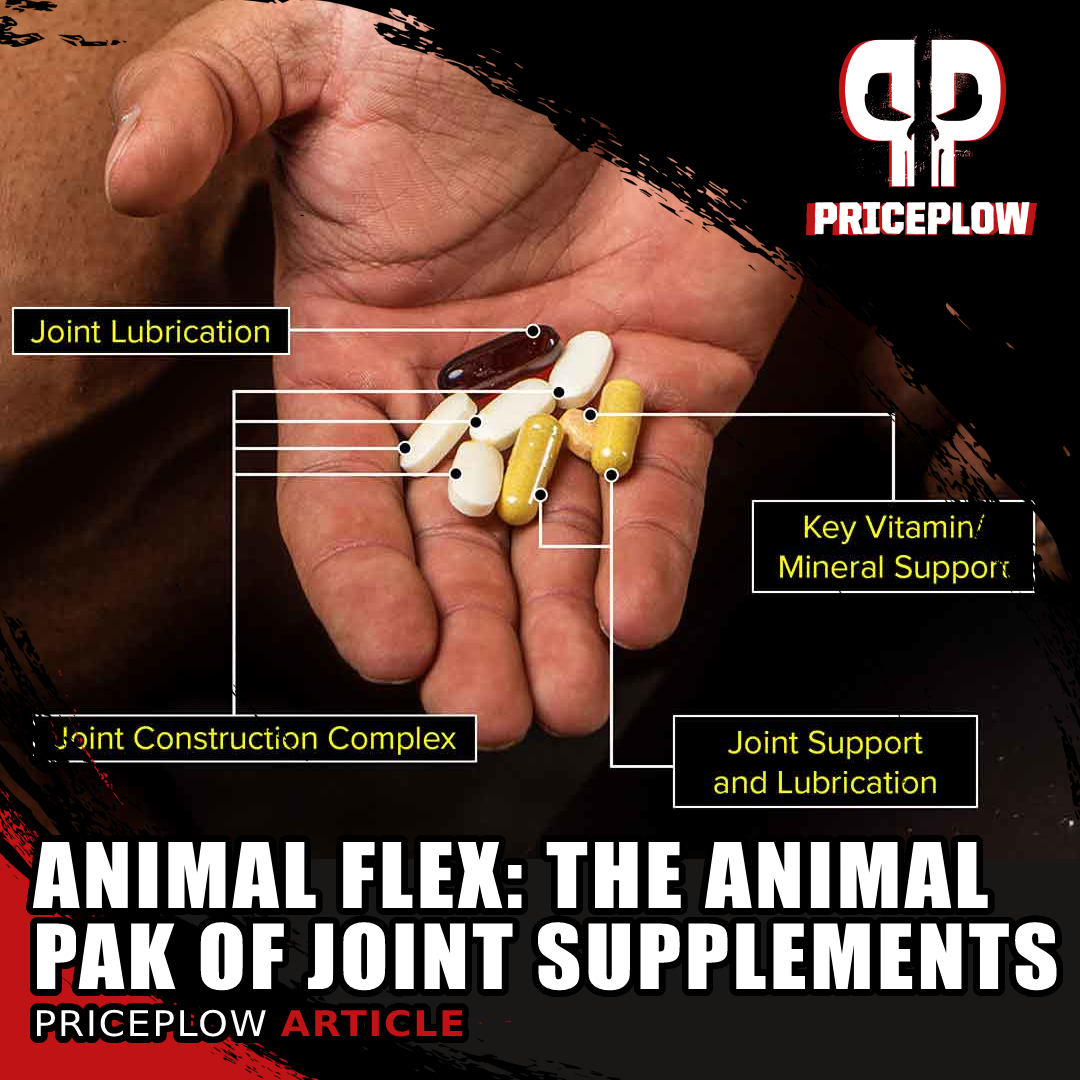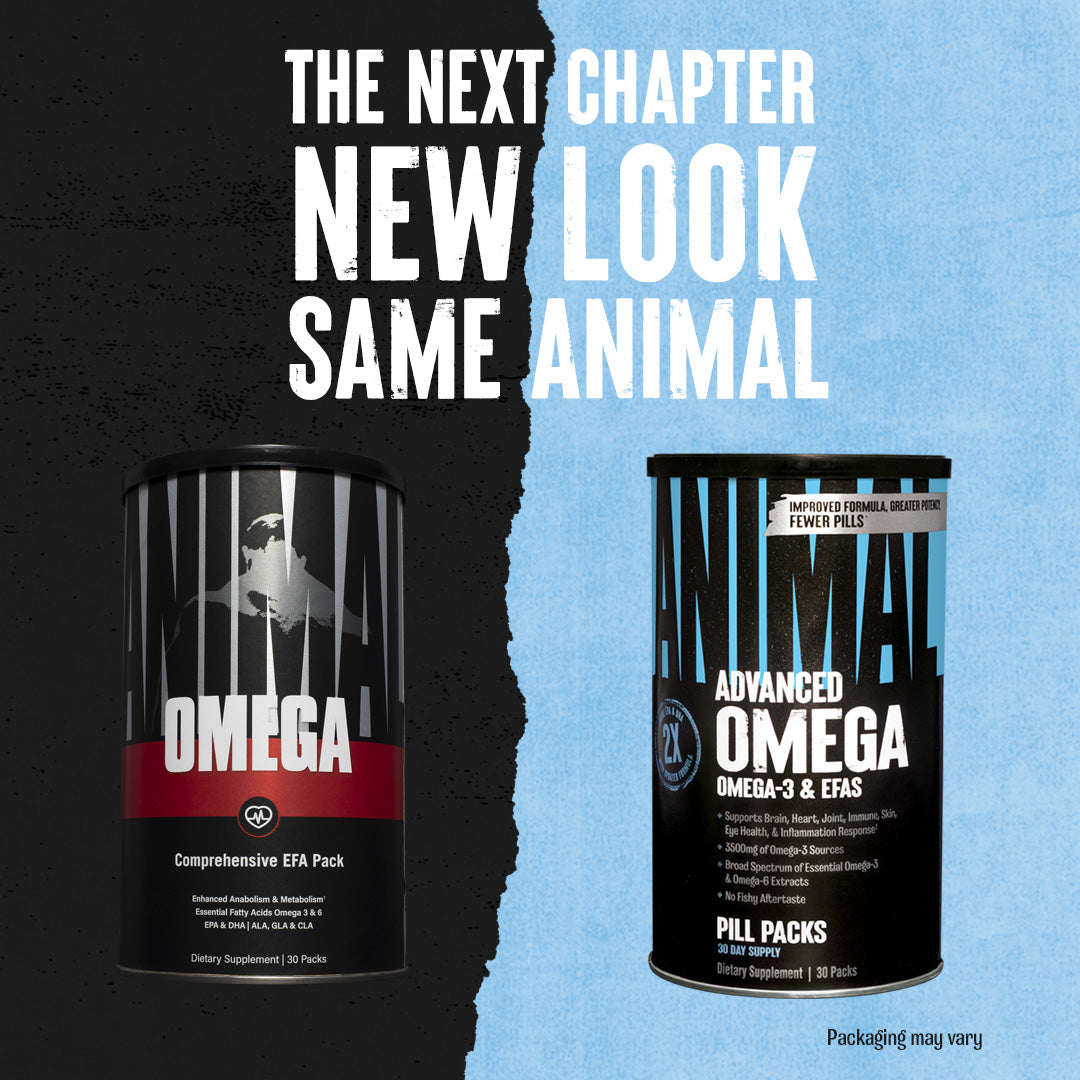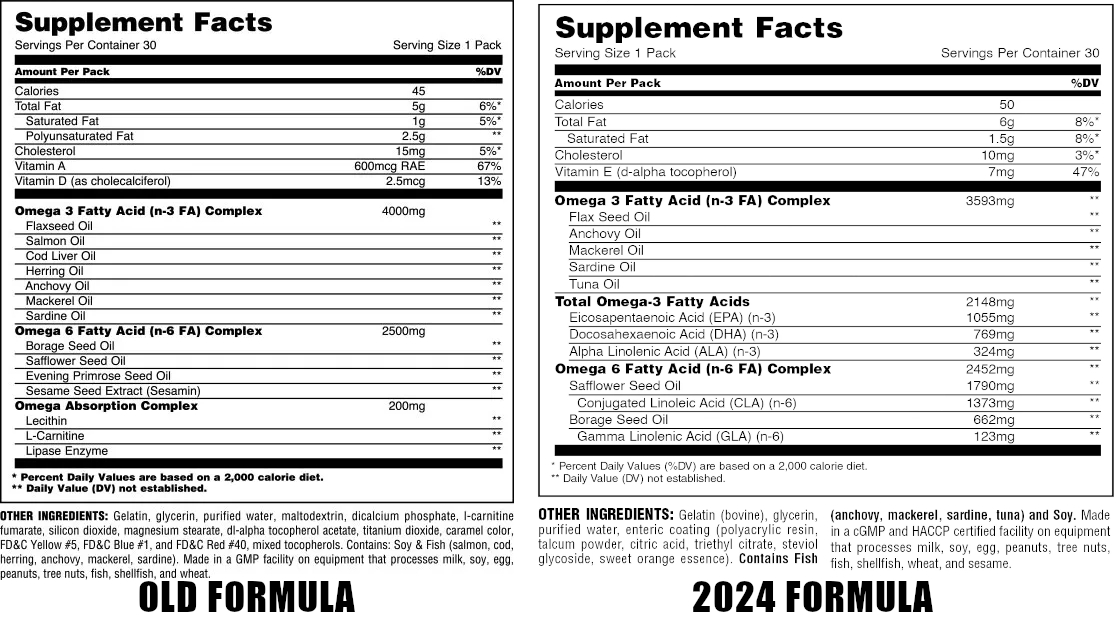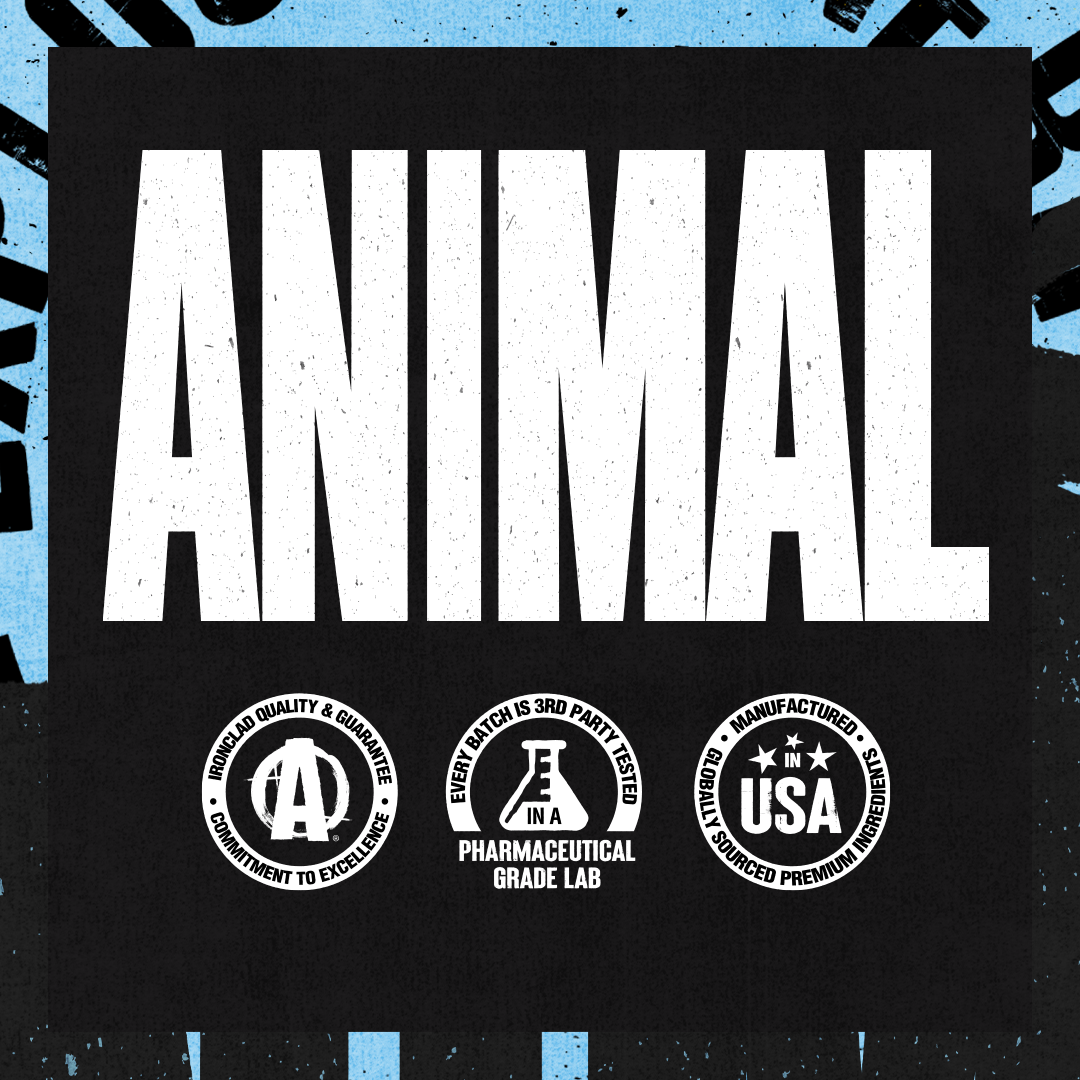Animal Omega has been updated, now with fewer softgels, just like the recent updates to Animal Cuts and Animal Pak!
When it comes to our diets, we are far too often concerned about calories and total fat, while ignoring the importance of the quality of fat we eat. Today, we focus on Animal Omega, an essential fatty acid supplement pack meant to improve our fatty acid ratios and provide a unique arrangement of fats that aren't normally ingested in our diets.
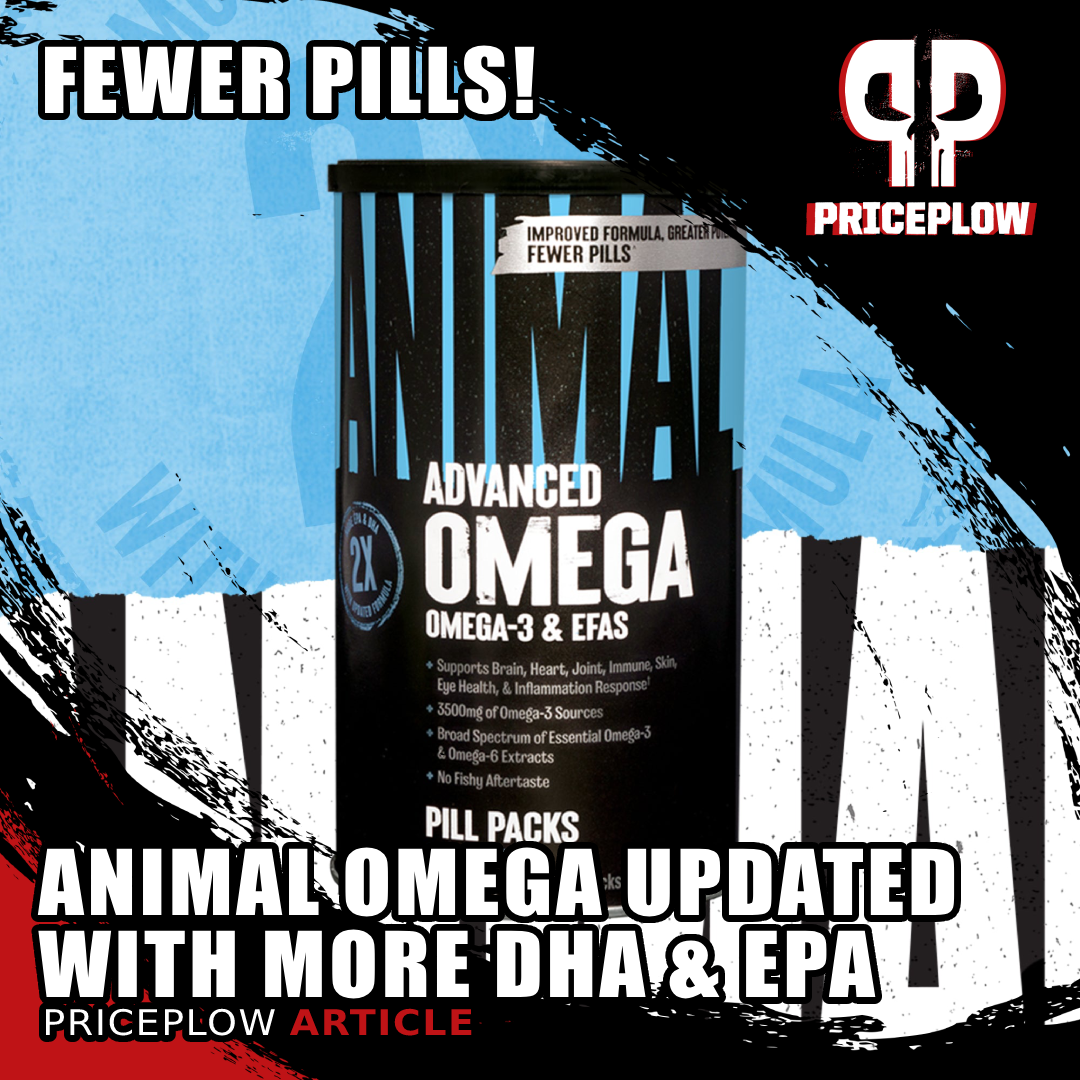
Animal Omega has been updated in 2024 with a new formula, featuring fewer pills, more EPA & DHA, a non-proprietary formula, and no more cod liver oil!
Updated in 2024 with seven different sources of omegas, this heart-health focused supplement is built to lower inflammation and improve lipid levels, and includes a few ingredients to improve fatty acid absorption, transport, and oxidation. First, let's talk about why we're here.
The overwhelming data on omega-3:omega-6 ratios
As you can imagine, there have been countless studies on the topic. There is strong research showing that humans (and animals) had an omega-3:omega-6 ratio close to 1:1 prior to the industrialization of food,[1-4] and ratios skewed against omega-3 consumption are predictive of mental illness,[5-20] cardiovascular disease,[1,21] insulin resistance and general metabolic dysfunction,[22-25] diabetes,[26-28] and obesity[29,30] -- and the evidence is further strengthened with data on childhood obesity.[31] The data is quite clear: low omega-3 intake paired with high omega-6 intake -- which is what the Western diet has become[1,32-34] -- is extraordinarily deleterious to one's health.
How do we fix these issues? As always, we encourage a diet-first approach, which consists around the removal of ultra-processed foods and refined sugars/carbohydrates. But in addition, it's wise to boost the quality fats as well, and that's what we're doing with Animal Omega. Stack it with Animal Flex, and you're on your way to a far lower inflammation year.
Over 90 studies are covered in this article, so let's dig in after checking PricePlow's coupon-powered prices:
Universal Animal Omega – Deals and Price Drop Alerts
Get Price Alerts
No spam, no scams.
Disclosure: PricePlow relies on pricing from stores with which we have a business relationship. We work hard to keep pricing current, but you may find a better offer.
Posts are sponsored in part by the retailers and/or brands listed on this page.
Note: In the image above, make sure you're getting the version you want. In 2024 both versions will be at retailers. AnimalPak.com will have the most up-to-date formula!
This area is reserved for Team PricePlow's upcoming Product Update video.
Subscribe to our channel and sign up for notifications so you catch it when it goes live!
Animal Omega Ingredients
Since we first wrote about Animal Omega in 2022, Animal has tweaked the formula in 2024 to include more EPA, DHA, and CLA, making it more powerful than ever before -- but with fewer pills!
In a pack of Animal Omega, you get four softgels and one capsule containing the following blends:
-
Omega-3 Fatty Acid (n-3 FA) Complex - 3593 mg
This complex contains nearly four grams of total fish oil - far more than what most consumers are taking or getting from diet. First, let's cover the benefits of omega-3 and fish oil consumption in general, and then detail a bit more about each specific one.
In the intro, we cover the numerous concerns with regards to poor omega-3 status. Let's work to fix that below, which have been shown to yield the following benefits:
Benefits of Omega-3 Supplementation
If we've become deficient in omega-3 -- largely due to lack of fatty fish eating in lieu of processed foods -- then one step is to supplement more. In general, researchers have seen the following benefits from omega-3 (and fish oil) supplementation:
-
Improved lipid levels: reduced triglycerides and increased HDL
There are literally dozens of studies demonstrating the well-known effect that fish oil has on triglycerides. We won't cite them all, but will reference many of the meta-analyses and reviews that continually verify this effect.[35-39]
In addition, there are two meta-analyses showing a slight improvement to HDL levels with fish oil.[37,39]
Together, these two mark an overall improvement in metabolic function, since the triglyceride:HDL ratio is a great proxy for insulin sensitivity[40,41] and the pair is a far better predictor of cardiovascular disease and mortality than LDL cholesterol![41-44]
-
Mood improvements
Similarly, we have dozens of studies confirming omega-3 fish oil's effects in combating mood disorders, with multiple systematic reviews statistically verifying them.[45-49]
-
Reduced anxiety
Interestingly, fish oil's benefits go beyond mood, but it also seems to reliably lower anxiety levels.[50-54]
-
Focus in children
Not that children are likely to take a massive Animal Omega pack, but there is plenty of research showing omega-3 supplementation improving focus in "focus-deficient" children,[55] and this is likely to translate to adults as well.
-
Blood Pressure Reduction
Fish oil has a small yet significant effect on blood pressure in hypertensive individuals.[56] While reducing sugars and overall processed carbohydrate intake is likely to drive a greater impact on this measure (along with the other concerns in this list), omega-3 seems to reliably help a little bit as well.
-
Reduction in Overall Inflammation
Fish oil has been shown to reduce numerous inflammatory markers in multiple types of individuals.[57-62] It's worth noting that many of the successful studies used decently large doses -- comparable to what's provided in Animal Omega.
Paired with Animal Flex (which adds a few other unique fatty acids that aren't in Animal Omega), you have an incredible inflammation-reduction stack.
The above list are the most well-demonstrated effects, but there are clearly more. For instance, a meta-analysis shows a slight reduction of cognitive decline,[63] but not to the extent of some of the stronger effects listed above.
The major point is that there's an extremely solid argument to make for fish oil consumption if you have anything remotely resembling a Western diet. With that said, we still encourage the reduction of ultra-processed foods and refined sugars.
Now let's briefly look at each oil specifically:
-
Flaxseed Oil
Flaxseed contains a high amount of alpha-linoleic acid (ALA),[64] the omega-3 fatty acid that's often forgotten compared to the DHA and EPA in the fish oils below. A review published in 2020 states that it is protective against cardiovascular disease, high blood pressure, insulin resistance, and inflammation, and is promising in assisting with metabolic health.[65]
-
Anchovy Oil
Coming from everyone's favorite pizza topping, anchovy oil has powerful antioxidant properties[66] that have been shown to improve menstrual cramping and discomfort.[67] Even better, it was shown to reduce abdominal pain and the women using it required fewer doses of over-the-counter painkillers.[67]
-
Mackerel Oil
Mackerel is a cold-water fatty fish whose oil has been shown to slow the progression of coronary atherosclerosis (primarily by reducing blood clotting factors) in animal models.[68] An interesting study showed that its fermentation (which we don't have here) promotes hair growth![69]
-
Sardine Oil
Sardine oil is a quality source of EPA (Eicosapentaenoic acid),[70] one of the three primary healthy omega-3 fatty acids alongside DHA and ALA.
-
Tuna Oil
Meet "The Animal Pak of Joint Supplements": Animal Flex! And if this many pills isn't your style, take a look at the collagen-boosted Animal Flex Powder.
Tuna oil is high in DHA and has been shown to modulate gut microbiota and even alleviate obesity in mice.[71]
The omega-3 totals (2148mg total yield)
All combined, a serving of Animal Omega provides the following three omega-3 fatty acids:
- 1055mg of EPA (Eicosapentaenoic Acid)
- 769mg of DHA (Docosahexaenoic Acid)
- 324mg of ALA (Alpha Linolenic Acid)
-
-
Omega-6 Fatty Acid Complex
While we're biggest on pushing our ratios towards omega-3 fatty acids, there are some omega-6 fatty acid containing oils that have some incredible health-boosting properties, and we don't get much of them in our diet, making a good reason for supplementation:
-
Safflower Seed Oil - 1790mg (yielding 1373 CLA)
High-dosed safflower oil has been shown to reduce waist circumference, blood pressure, and fasting blood sugar.[72] Long used in traditional Iranian medicine, most of the wide-ranging beneficial therapeutic effects are attributed to a constituent named hydroxysafflor yellow A.[73] There's some interesting evidence in animal models showing that it restored testosterone and fertility in impaired animal models.[74]
The safflower seed oil here is a source of CLA, short for conjugated linoleic acid, a fatty acid that can actually support fat loss and protect lean muscle tissue.[75-77]
-
Borage Seed Oil - 662mg (yielding 123mg GLA)
Borage seed oil is a great source of gamma-linolenic acid (GLA), and numerous studies have shown that it has anti-inflammatory action that protects skin against conditions like eczema and dermatitis - both topically and orally.[78-82] It has a protective effect on DNA,[83] leading to various beneficial effects including some that combat arthritis and inflammation.[84]
-
Dosage and Instructions
Take a pack of Animal Omega once daily - larger users can consider two packs. Timing doesn't matter, but they're likely best taken with a meal.
If you're susceptible to "fish oil burps", consider freezing them and taking them just before bed.
The 2024 Update: No more cod liver oil!
The biggest change to the updated version in 2024 is the removal of cod liver oil. This is good news because cod liver oil overconsumption has been linked to vitamin A toxicity,[85] a condition that's growing in prevalence -- an estimated 1 in 3 Americans may suffer from it.[86]
Additionally, Vitamin D (as cholecalciferol) has been removed. Vitamins A and D are both fat-soluble alcohols that promote calcification once levels accumulate enough,[87-92] which is counter to the typical goal of omega supplementation. So Animal wisely removed them -- you can always add them back elsewhere if you so choose.
Salmon oil and herring oil have also been removed in lieu of tuna oil, a source which should need no introduction to any Animal athletes!
Additionally, the small doses of L-carnitine and lecithin (which were likely not contributing much at their low amounts) were also removed, with vitamin E replacing the lecithin. L-carnitine is a great ingredient -- it just needs higher doses. If you want a great way to supplement it, it's in Animal Cuts Powder and Animal Cuts Non-Stim Powder.
Animal Omega: A full spectrum of essential fatty acids
The research is pretty clear: our omega-3 fatty acid intake is too low, and our omega-6 fatty acid intake is too reliant on processed oils that provide no nutritional value. Animal Omega is a great first step in restoring the balance -- but it still requires work in removing ultra-processed foods from diet.
The "pack" method makes an incredible difference here, allowing Animal to include an additional capsule for the absorption ingredients. We're surprised that we don't see more essential fatty acid supplements including lipase, especially.
A great anti-inflammatory supplement to stack alongside is Animal Flex, while dieters will definitely enjoy Animal Cuts or Animal Cuts Powder -- we prefer the latter due to the amount of L-carnitine that'll be included to assist with fatty acid transport. On that note, stay tuned to PricePlow and our Animal news, there's more on the way:
Universal Animal Omega – Deals and Price Drop Alerts
Get Price Alerts
No spam, no scams.
Disclosure: PricePlow relies on pricing from stores with which we have a business relationship. We work hard to keep pricing current, but you may find a better offer.
Posts are sponsored in part by the retailers and/or brands listed on this page.
Note: In the image above, make sure you're getting the version you want. In 2024 both versions will be at retailers. AnimalPak.com will have the most up-to-date formula!
